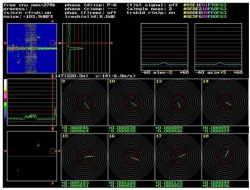 |
| Radar tesztprogram |
The new system developed by the Hungarian consortium combines complex signal and image processing with a new method to drastically improve the collision avoidance system of robot vehicles: the drone – or the anti-drone interceptor respectively – processes information collected from various sources by “thinking and becoming smarter”. The BHE Bonn Hungary Elektronikai Kft. in cooperation with the Institute of Technical Physics and Materials Science, Centre for Energy Research of the Hungarian Academy of Sciences, three departments of the Budapest University of Technology and Economics and the ASTRON Informatikai Kft developed an integrated solution using radar, video and telecommunications technologies which enables drones not only to map their environment but also to interpret and use the collected information based on cognitive mechanisms and feedback. At the same time, reversing this process enables to detect and avoid “unwelcome” drones and even to force a controlled landing, if necessary.
The targeted objectives of the project have been achieved by developing the following fields and systems:
- special 24GHz 4D MIMO radar test equipment with modular subsystems
- modern 20 MP video signal processing with smart image learning
- robust OFDM air-to-ground telecommunications with range 50 percent extended
- Linux-based integrated processing, simulation and design software
- theory and algorithms of stochastic non-parametric radar signal processing
- cooperation skills and navigation of an UAV fleet, theoretical and experimental examinations
As a result of the experimental development, the navigation and content generating capabilities of the drones have drastically improved. Collision avoidance tests combined with learning have proven that the environmental analysis of radar-based video navigation (featuring a range of several hundred meters and an accuracy of one centimetre) has contributed to the creation of an efficient system which can be used for various purposes of drone missions. This is an important milestone in the development of unmanned aerial vehicles. By reducing the reaction time of drones, they become capable of solving complex and difficult tasks, such as flying in formation, mutually supporting each other.
There is also further potential in the utilisation of the present intelligence system as a powerful long-range interference system or a modern combination of universal sensor and management system which can be successfully down- and up-scaled within the frequency range.
Partner institutions:
-
BHE Bonn Hungary Elektronikai Kft.
-
Research Centre for Natural Sciences, Hungarian Academy of Sciences
-
Budapest University of Technology and Economics
-
ASTRON Informatikai Fejlesztő és Tanácsadó Kft.
Funded project: KMR_12-1-2012-0008
Cognitive methods strengthen the collision avoidance system of vehicles






